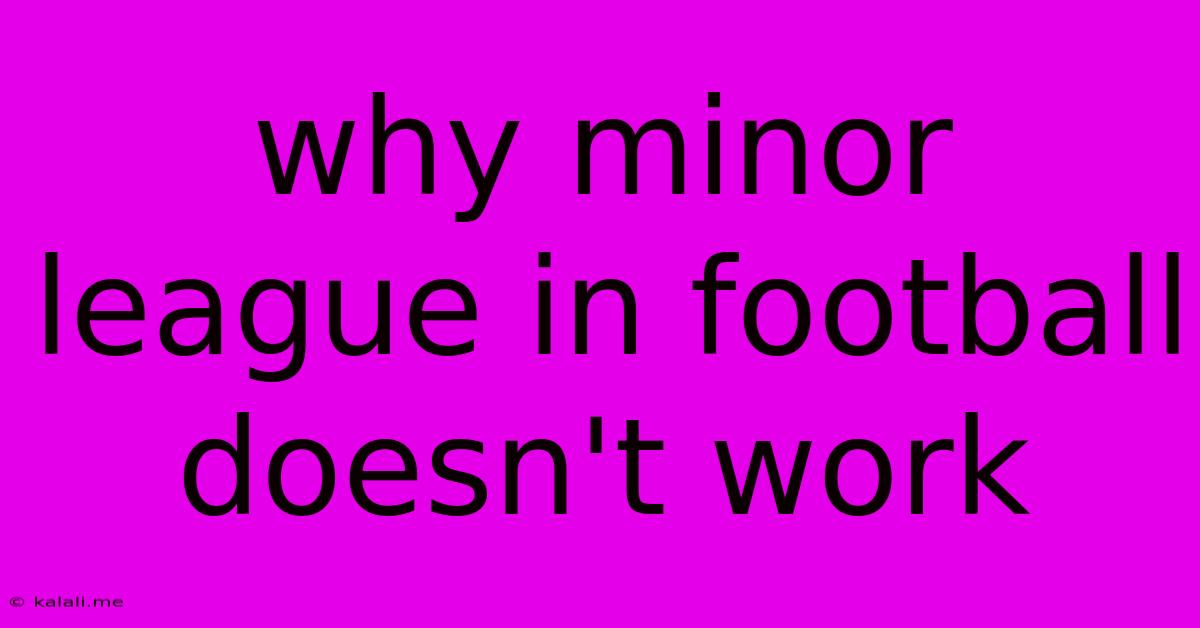Why Minor League In Football Doesn't Work
Kalali
Jun 06, 2025 · 3 min read

Table of Contents
Why Minor Leagues in Football Just Don't Work: A Deep Dive into the Challenges
Meta Description: The dream of a robust minor league system in football seems appealing, but faces insurmountable hurdles. This article explores the complex reasons why a successful football minor league remains elusive, from financial instability to player development issues.
The idea of a thriving minor league system in American football, mirroring the success of baseball's minor leagues, is a recurring fantasy for fans and commentators alike. However, the reality is far more complex. Despite numerous attempts and proposed models, a truly successful and sustainable minor league football system has consistently proven elusive. This isn't simply a matter of logistics; it's a confluence of factors rooted in the fundamental differences between football and other major sports.
The Financial Cliff: Unsustainable Economics
One of the most significant barriers is the sheer cost of operating a football team. Unlike baseball, where players can develop over several years in lower leagues on relatively modest salaries, football requires significant investment. Equipment, coaching staff, facilities, and player salaries all contribute to a financial burden that many minor league franchises would struggle to bear. The revenue streams, particularly from ticket sales and sponsorships, are often insufficient to cover these costs, leading to financial instability and frequent league collapses. This contrasts sharply with baseball's established minor league infrastructure, which benefits from decades of established revenue sharing and player development pathways.
Player Development and the NFL Pipeline: A Broken System?
The established NFL Draft already acts as a de facto minor league system, albeit a highly selective one. College football provides a robust developmental pathway for aspiring professionals. While some argue that a formalized minor league could improve player development further, the existing system, while imperfect, feeds the NFL's talent pipeline effectively. Creating a parallel system would likely draw talent away from college football, potentially weakening the collegiate game and disrupting the established scouting and recruitment processes.
The Physical Toll: Injury Risk and Player Longevity
Football is a brutal sport, characterized by a high risk of injury. A minor league system would expose players to potentially more games and even more contact, increasing the risk of significant injuries that could prematurely end careers. This concern raises ethical questions about player welfare and the long-term health consequences of prolonged participation in a highly physically demanding sport. The NFL already grapples with the long-term effects of concussions and other injuries; adding another level of play would amplify these concerns.
The Scheduling Nightmare: Competition and Logistics
Scheduling games in a geographically diverse minor league would pose a logistical nightmare. Travel costs, conflicting schedules with existing collegiate and high school football seasons, and coordinating game days would present enormous operational challenges. This logistical complexity contrasts significantly with baseball's more localized minor league structure, which is geographically better suited to consistent game scheduling.
The Saturation Point: Audience and Interest
The existing football landscape is already saturated. Fans have ample options to watch professional, collegiate, and high school football. A minor league would compete for a limited audience and sponsorship dollars, making it difficult to gain traction and build a sustainable fan base. This lack of widespread public interest would further exacerbate the financial instability discussed earlier.
In conclusion, while the concept of a minor league in football is alluring, the realities of its implementation present formidable challenges. The financial burden, the existing player development pathway through college football, the heightened risk of injury, logistical complexities, and the saturated sports market all contribute to the ongoing failure of minor league football endeavors. While the dream persists, overcoming these deep-seated hurdles remains a monumental task.
Latest Posts
Latest Posts
-
Twitter Password Not Working From Logging With Google
Jun 06, 2025
-
Air Conditioner Drian Too Much Water
Jun 06, 2025
-
Ac Unit Outside Blowing Cold Air
Jun 06, 2025
-
What Is Involved In Upgrading To 200 Amp Service
Jun 06, 2025
-
What Is A Word For Someoen Relying On Someone Else
Jun 06, 2025
Related Post
Thank you for visiting our website which covers about Why Minor League In Football Doesn't Work . We hope the information provided has been useful to you. Feel free to contact us if you have any questions or need further assistance. See you next time and don't miss to bookmark.